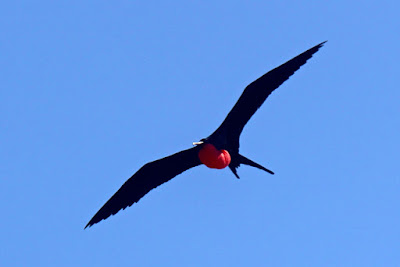 Saturday, April 9, 2016, WTRD 91
Saturday, April 9, 2016, WTRD 91
We were out the starting gate at 7:30 this morning on the hunt for Red Footeed Boobies.
Unlike the Blue Footed Boobies that nest on the ground, the Red Footed Boobies have shorter legs that inhibit walking, so their nests are in trees. There are far fewer Red Footed Boobies, and looking for them in trees is more difficult.
We landed on a lovely beach where sea lions bathed in the waves. and then began our ascent upwards where we would find some trees.
Unlike the Blue Footed Boobies that nest on the ground, the Red Footed Boobies have shorter legs that inhibit walking, so their nests are in trees. There are far fewer Red Footed Boobies, and looking for them in trees is more difficult.
We landed on a lovely beach where sea lions bathed in the waves. and then began our ascent upwards where we would find some trees.
However, we were successful and got some pretty good photographs, even though we had to hike up a steep trail on San Cristobal to get to the nests of the Red Foot.
 |
| Nesting Blue Footed Bobbies, but no trees. |
 |
| Reed Foot, Blue Billed Booby shading her egg...doesn't need to keep it warm here. |
 |
| Red Foot in flight |
We had to hunt, and play peek-a-boo, but were successful in seeing quite a few of these Red Footed Boobies.
After two hours of walking, we made our way back
 |
| Seemed steeper going back down |
to the boat where we showered, relaxed, and had a terrific lunch on the fan tail while we circled the huge rock where we will be snorkeling later this afternoon.
 |
| Gill and Julie |
 |
| Mick and Peter |
 |
| Brendan, Dylan, and Julie |
 |
| Julie, Peter, and Leslye |
 |
| Russ, Nathan, Leon, and Bev |
But before we snorkel, we go for another walk-about to spy the nesting sight of the Magnificent Frigate Bird. The frigate birds were plentiful and beginning their nesting season. Unfortunately for us, none of them had their nests close to the paths and in good camera shot.
The terrain is rocky, and we have to concentrate more on our footfall than skyward as we pick our way across the island.
The pictures and video I took of the frigates nesting on Isla Isabela of the coast of Mexico in 2009 are still the best. I was able to capture a couple of the males from quite a distance in the nest and in the sky.
The terrain is rocky, and we have to concentrate more on our footfall than skyward as we pick our way across the island.
 |
| Females looking for a handsome male. |
In the late afternoon, we went for a deep water snorkel at Split Rock. Andres tells us this is one of the favorite dive spots in the Galapagos. Today when we get there, the current is strong and the water clarity is not so good.
The bottom is deep, and we can not see the bottom. We were fortunate to see a beautiful eagle ray with leopard spots and a large turtle. Photos courtesy of our guide Andres and his Go-Pro.
We looked but couldn't find a hammer head shark. I think I was relieved actually not see one. It was sad to think this was our last snorkel.
After an evening of exchanging addresses, drinking wine, and a nice dinner, we retired one last time on the Queen Beatrice.
We leave in the morning for Quito and will arrive late in the afternoon.
We leave in the morning for Quito and will arrive late in the afternoon.
We will have one full day in Quito on Monday where we will do a morning city tour, do some shopping and resting in the afternoon, have one last dinner with new friends, and leave for the airport by 9:30 pm. We take the red eye home early Tuesday morning.
All is Well with the Worrall Travel R's in Ecuador




















































